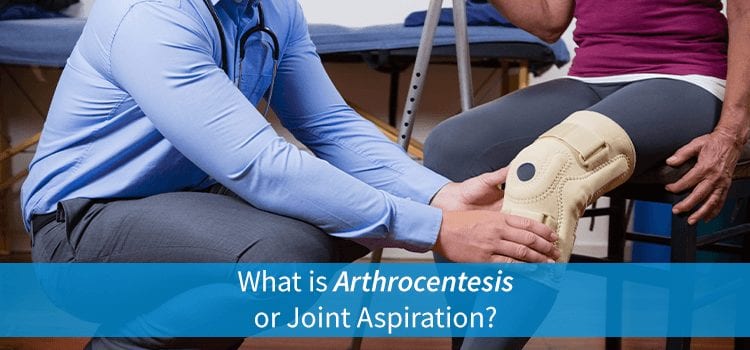If you’re suffering from joint swelling or pain, then your doctor may suggest a procedure called an arthrocentesis. Sometimes known as joint aspiration, this procedure involves using a needle and syringe to remove fluid from a swollen joint.
In many cases, this procedure only takes a few minutes to perform. And, it is rarely associated with complications. Use this guide to understand how arthrocentesis works, as well as how it can be used to diagnose your joint pain.
Understanding the Joints
Every move you make, from turning your head to running in a marathon, requires the cooperation of your bones, muscles, and joints. Your muscles are connected to skeletal bones by strong tissues called tendons. These tendons serve to aid your muscles in moving your bones at junction points, called joints.
More specifically, joints refer to areas where two bones meet. Without them, we wouldn’t have the ability to move our limbs or walk.
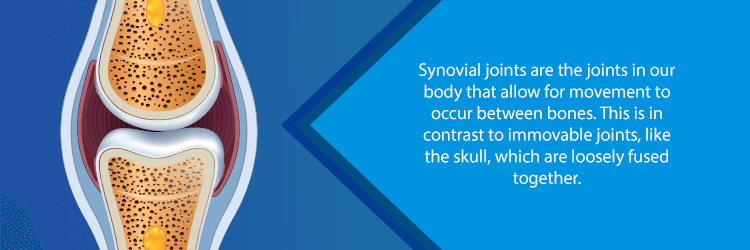
There are many different types of joints in your body. Synovial joints (unlike the immovable bones of your skull) are classified by the movements they allow. The four types of movable joints include:
- Pivot Joints: Joints that allow the bones to rotate. A cylinder-shaped bone is wrapped by another ligament or bone to form a ring around it. The first and second vertebrae of the neck form a pivot joint that enables the head to turn.
- Hinge Joints: Joints that permit for the bending and straightening of long bones. Bones that make up a hinge joint come together at smooth surfaces and are bound by strong ligaments. Anatomists classify the elbow and knees as hinge joints.
- Ball-and-Socket Joints: A type of joint that allows for the greatest range of movement. These joints consist of a bone with a spherical head that fits into a divot (or socket) of another bone. Tendons and ligaments hold these bones together. Your hips and shoulders are categorized as ball-and-socket joints.
- Gliding Joints: These joints meet at flat surfaces to glide past one another along the plane of the joint. Some bones in the wrists and ankles function as gliding joints.
For your joints to work effectively, they need lubricant to facilitate movement with minimal friction. Most joints contain a substance known as synovial fluid, which helps to cushion the bones and promote smooth movements. In addition, synovial fluid delivers nutrients to the protective cartilage that lines these joints.
Lastly, a tiny, slippery sac, known as a bursa, resides between our bone and soft tissues. A bursa sac is responsible for producing and storing the synovial fluid which bathes our joints.
What is Arthrocentesis?
Over time, the amount and composition of the synovial fluid in joints can change. For example, those with knee osteoarthritis may develop excess or thinner synovial fluid in the knee joint. Orthopedic doctors use arthrocentesis to remove some of this extra synovial fluid from a joint or bursa.
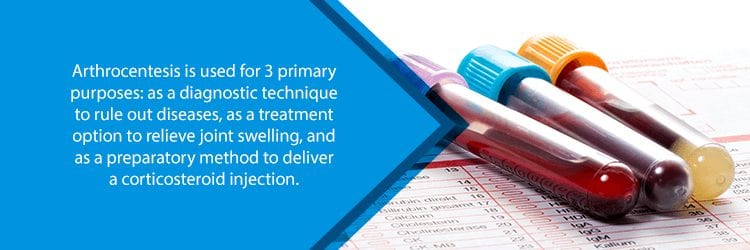
Doctors typically recommend this procedure for three reasons:
Diagnostic Testing
If you are having problems with one or more of your joints, then your doctor may use arthrocentesis to confirm or rule out certain conditions. As a diagnostic technique, this process involves extracting some of the synovial fluid from the joints and sending it to a lab for analysis. From there, your orthopedist will conduct specific tests depending on what he or she believes may be the cause of your joint pain. Specifically, your doctor may be:
- Taking a bacterial culture of the fluid to determine joint infection or septic arthritis.
- Looking for uric crystals when your doctor suspects gout.
- Determining if there is blood in the joint space due to trauma or injury.
- Diagnosing rheumatoid arthritis or other inflammatory conditions by obtaining a white blood cell count.
Relieving Pain
Arthrocentesis can also relieve pain and pressure on your joints. For example, joint aspiration involves removing excess fluid that may be causing swelling, discomfort, or limited movement. Doctors choose to do this when they already have obtained a joint diagnosis.
In particular, a knee arthrocentesis may be suggested for those who suffer from osteoarthritis. During this procedure, your surgeon will remove the excess joint fluid and discard it. Since your doctor has already diagnosed your condition, you will not need further lab testing.
Preparing the Area for an Injection
If you have had joint problems that didn’t respond to oral medications or other conservative treatments, then your doctor may prescribe a therapeutic injection. For example, a corticosteroid injection may be used to reduce the inflammation associated with arthritis, bursitis, or other joint conditions. Another common type of injection is called viscosupplementation. During this procedure, your doctor injections a lubricating fluid that occurs naturally in your body, known as hyaluronic acid, into the joint. This helps the joint to move better and reduces pain.
For these injections to be effective, your physician will need to remove excess fluid. In many cases, doctors also choose to administer steroidal injections during the joint aspiration procedure.
Arthrocentesis: What to Expect
In most cases, doctors can perform this procedure in their office. In fact, you can most likely expect to go home the same day.
Preparing for Arthrocentesis
Most patients don’t need to do anything out of the ordinary to prepare for this procedure. All patients, however, should discuss any current health issues prior to receiving an arthrocentesis. For example, talk to your doctor if you think that you’re pregnant or suspect that you have a condition such as an infection or bleeding disorder. Tell your doctor about any medications or joint supplements you take. And, finally, discuss any known allergies to surgical materials, including latex, anesthesia, or medications.
Your doctor will advise if you should stop taking any of your medications before the procedure. If your physician orders diagnostic testing for glucose levels, you may need to fast in order to obtain accurate labwork.
Those who undergo procedures like knee arthrocentesis may need to find a ride home after the procedure, as it is common for patients to experience temporary leg stiffness after the procedure.
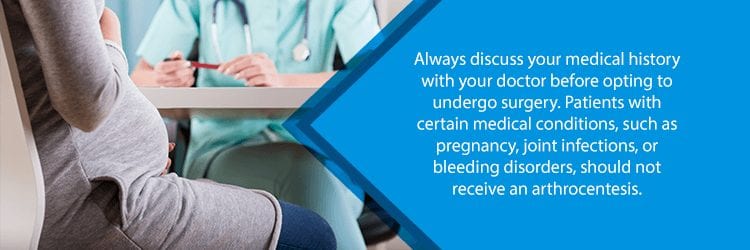
During the Procedure
While some minimally invasive procedures can take well over an hour to perform, arthrocentesis usually lasts only 10 minutes (or less).
Before the procedure, your doctor will ask you to sit or lie down depending on the area that will be aspirated. This position ensures your comfort and gives the doctor easy access to the swollen area. Then, your doctor will mark the designated spot for injection and clean the area surrounding it.
Next, your physician will administer a local anesthetic to numb the area. In some cases, your doctor may use a general anesthetic instead. This approach is more typical for patients with high anxiety or when the needle needs to access a deeper joint to treat a condition such as hip arthritis.
With the area numbed, your doctor will insert a needle with a syringe into the area. In some cases, your medical professional may use an ultrasound to guide the needle to the exact location. As the needle reaches the affected joint or bursa, your doctor will use the syringe to remove excess synovial fluid.
If the arthrocentesis procedure is being used for pain relief or diagnosing a condition, the needle is then removed, the area is bandaged, and slight pressure may be applied to the area to slow any bleeding.
If your doctor also intends to use a therapeutic injection, he or she will remove the syringe with the synovial fluid. The needle stays in place while your orthopedist attaches a different syringe with medication. Your doctor will then inject the corticosteroid medication and remove the needle and syringe.
Recovery Time
Recovery time from arthrocentesis is usually quick. In fact, some patients can return to normal activities right after the procedure. Others may need to rest for a day or two before resuming with their daily routine.
Most patents don’t have any major issues after the procedure. Since the procedure requires a local anesthetic, some may feel pain after this medication wears off. In addition, many patients experience some soreness a day or so after the arthrocentesis.
Complications of arthrocentesis are rare. In most cases, these side effects can include bruising or minor bleeding in the joint. When the procedure involves a therapeutic injection, there may also be a loss of pigmentation in the skin or brief swelling of the joint.
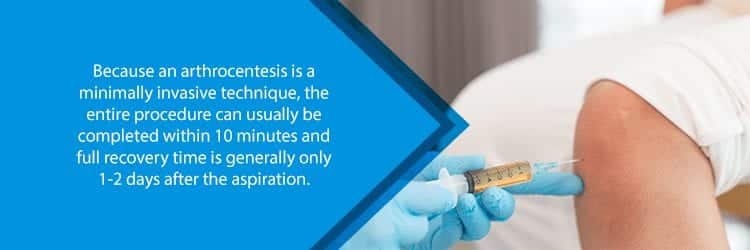
Finding Help for Your Joint Pain
Are joint problems keeping you from enjoying life? NJ Spine & Orthopedic is ready to help. By scheduling an appointment with us, you can rest assured that a dedicated team of caring professionals will be there to support you. From diagnosing the source of your joint pain to ensuring that your recovery time is as quick as possible, we make sure you are comfortable every step of the way.
NJ Spine & Orthopedic specializes in the latest minimally invasive techniques, like arthrocentesis, to help you regain control of your life. Schedule a consultation today to find out how our board-certified back specialists in NJ can help!

